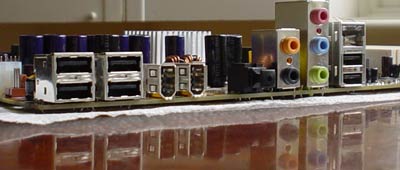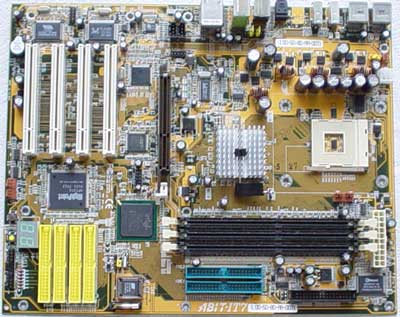Intel 845E Motherboard Roundup - August 2002
by Evan Lieb on August 5, 2002 1:07 AM EST- Posted in
- Motherboards
ABIT IT7
|
Motherboard Specifications |
|
|
CPU
Interface
|
Socket-478
|
|
Chipset
|
Intel
82845E MCH
Intel 82801DB ICH4 |
|
Bus
Speeds
|
100-250MHz
(in 1MHz increments)
|
|
Core
Voltages Supported
|
up
to 1.7V (in 0.025 increments)
|
|
I/O
Voltages Supported
|
N/A
|
|
DRAM
Voltages Supported
|
up
to 3.2V (in 0.1V increments)
|
|
Memory
Slots
|
3
184-pin DDR DIMM Slots
|
|
Expansion
Slots
|
1
AGP 4X Slot
4 PCI Slots |
|
Onboard
RAID
|
High
Point HPT374 IDE Controller
|
|
Onboard
USB 2.0/IEEE-1394
|
USB2
Supported through South Bridge
TI FireWire Controller |
|
Onboard
LAN
|
RealTek
8100B
|
|
Onboard
Audio
|
Realtek
ALC650
|
What truly separates the ABIT IT7 from all the other Pentium 4 motherboards on the market today is its legacy free layout, dubbed the "MAX" series of motherboards. The ABIT IT7 does not have a single legacy port located anywhere onboard (its face plate design is obviously quite unique). The only thing that can be considered a "legacy" item is the floppy connector.

Legacy features have slowly but surely started to become less and less attractive to performance users, as faster USB and FireWire technologies have emerged. Therefore, it is quite understandable that ABIT has done away with legacy ports for the very high-end performance market. However, it is important to note that legacy ports are still an absolute must in the OEM market, where cost is the driving force behind most decisions (OEM's are very sensitive to price, whereas performance-driven users usually are not). It's clear the ABIT IT7 is aimed squarely at high-end performance users among other such markets.
ABIT was able to fit quite a bit extra on the PCB due to the IT7's legacy free nature. As a result, the IT7 is one of the most feature filled Pentium 4 motherboards on the market today.
 Like
its BD7II brother, the IT7's High Point HPT374 Controller provides options for
RAID 0, RAID 1, and RAID 0+1 arrays. The IT7 utilizes the ICH4's native support
for LAN in the form of the Realtek 8100B. The IT7 also utilizes the Realtek
ALC650, another feature native to the ICH4 South Bridge.
Like
its BD7II brother, the IT7's High Point HPT374 Controller provides options for
RAID 0, RAID 1, and RAID 0+1 arrays. The IT7 utilizes the ICH4's native support
for LAN in the form of the Realtek 8100B. The IT7 also utilizes the Realtek
ALC650, another feature native to the ICH4 South Bridge.
The IT7 also supports a hefty amount of IDE devices, with a total of 12; 8 are courtesy of the HPT374 chip. There's support for a staggering 10 USB 2.0 ports as well, 6 native USB 2.0 ports via the ICH4 South Bridge and an additional 4 via the onboard VT6202 USB2.0 chip. In addition, you have up to 3 IEEE 1394a FireWire ports at your disposal.
Stressing the IT7
The IT7 was able to make it through Prime95's torture tests for nearly 24 hours without a hiccup. We then decided to go into the BIOS and turn up the intensity a bit with Turbo mode. This didn't affect the IT7 at all. Finally, we decided to to populate all 3 DIMM slots with memory to see how it would hold. The IT7 handled it like a champ; yet again we saw no impact on the stability of the motherboard, even under these strict conditions.
All in all, we are pleased to see ABIT create such a solid piece of silicon. We eagerly anticipate future MAX motherboards, but would like to see a more mixed combination in the future, like a serial port or two. Even though this would take away from ABIT's "legacy free" campaign, we believe it would better serve consumers in current market conditions. Still, we will no doubt be keeping a close eye on how MAX progresses, and hope to see similar products from ABIT in the near future.











0 Comments
View All Comments